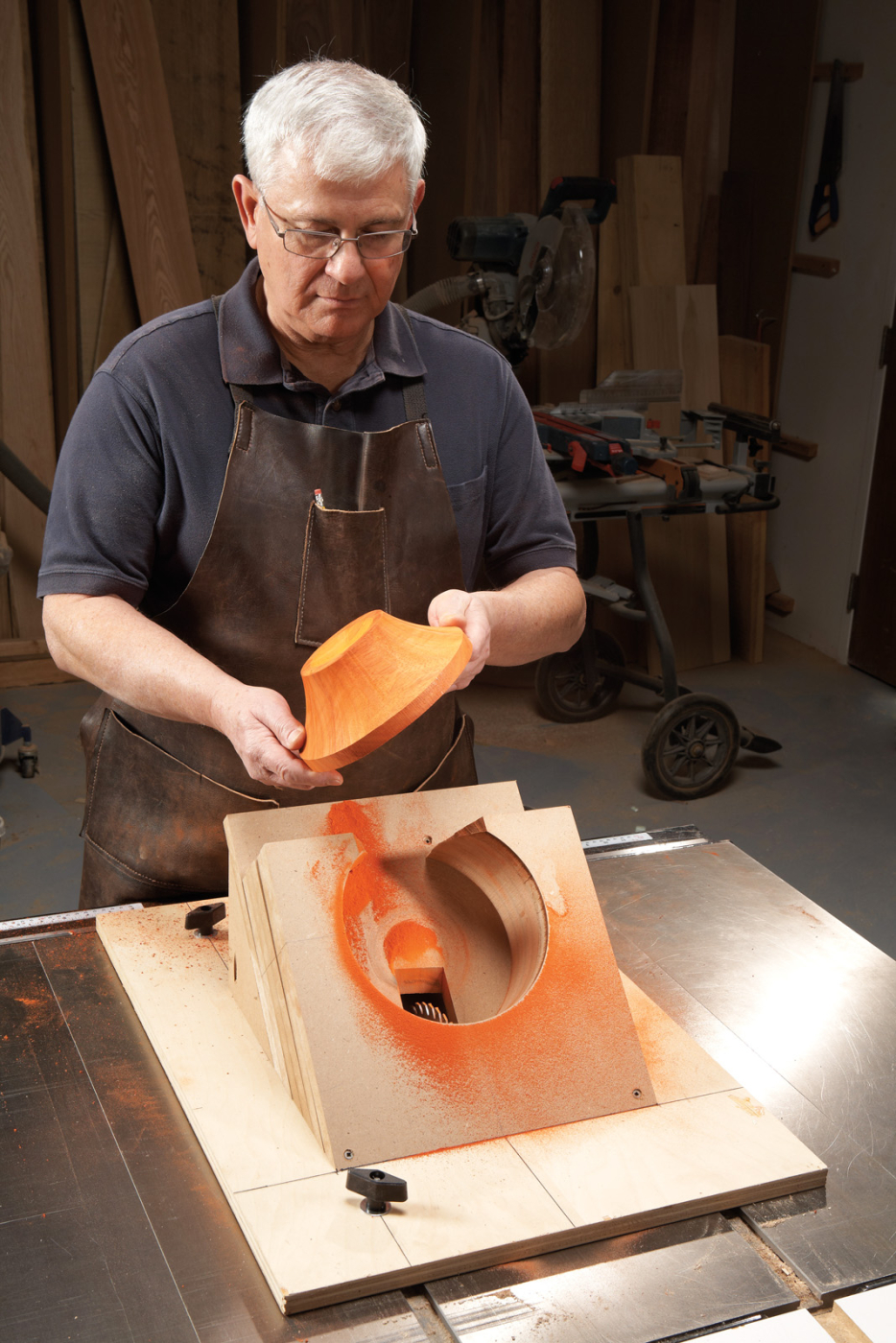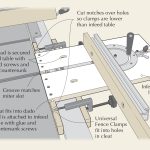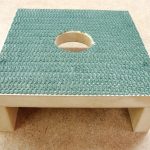We may receive a commission when you use our affiliate links. However, this does not impact our recommendations.
It’s just like sawing a cove molding, but now the wood is round.
“You’re kidding me!” That’s everybody’s first reaction when I tell them that I’ve figured out a way to make a bowl on the table saw.
Then they ask, “Isn’t it dangerous?” Believe me, if it were, I wouldn’t be writing about it. As long as you use my jigs and follow the simple instructions below to the letter, you’ll be perfectly fine.
Now to the harder question: Why do it? If you don’t have a lathe, the answer is obvious. You really don’t have to buy one if all you want to do is make a bowl. But if you do have a lathe, I’ll think you’ll be intrigued enough by this process to give it a try. It’s really amazing!
Make the blank
I designed these jigs for 8″ x 8″ turning blanks that are 3″ thick. Blanks of this size are widely available and come in a variety of species. (The bowl shown here is made from padauk). I prefer to use wood that is thoroughly dry—wet wood can clog up the jigs and might rust your saw. Many blanks aren’t dry enough; I recommend setting them aside until they are as dry as kiln-dried wood.
Caution: Don’t use cracked or knotty wood for making this bowl. It could break apart during the sawing operations. In any case, wear safety glasses, goggles or a face shield.
Flatten both sides of the blank with a belt sander, electric plane or hand plane, or by using a thickness planer. If you use a planer, temporarily fasten 3/4″ x 3″ x 16″ boards to both sides of the blank, to effectively lengthen the piece. On most planers, it’s not safe to mill pieces that are less than 12″ long.

1. Saw the bowl blank as round as possible. I use a circle-cutting jig, where the blank rotates on a pin like a record on a turntable. The result is a near-perfect circle.
Cut the blank into a 7-5/8″ dia. circle (Photo 1). When using the bowl-making jigs, you’ll get the best results if the blank is perfectly round. Cutting the blank freehand will work OK if you’re careful and go slow, but making a perfect circle is a cinch if you use a circle-cutting jig. You can buy one or make one yourself.
Note that the blank is 1/8″ smaller in diameter than the holes in the jigs you’ll be using.
Using the hollowing jig
First, put an 8″ dia. blade in your table saw. Any blade will do, but I’ve found that an outer blade from an 8″ stacked dado set leaves the smoothest surface.

2. Install a jig on your table saw for hollowing the interior of the bowl. Tighten two knobs to lock the jig in the miter slot, so it can’t move. Raise the blade so it’s even with the top of the saw table.
Install the hollowing jig (Photo 2 and Fig. A, page 61). Align the front of the jig with the front edge of your saw, then tighten the knobs of the locking miter bars. Adjust the height of the saw’s blade so the top of the blade is just a bit below the surface of the table.

3. Place the blank in the jig and raise the blade 1/16″. Rotate the blank one revolution. The result will be a dish-shaped, concave cut. Raise the blade another 1/16″ and repeat the procedure.
Place the blank in the jig. Press down lightly on the blank with one hand, turn on the saw and raise the blade 1/16″ (on my saw, that’s about 1/4 turn of the blade-elevation handwheel). Rotate the blank, clockwise, one complete revolution (Photo 3). (You might want to make a mark on the blank, so you can tell when you’ve turned the blank full circle.)

4. Remove the blank after a few passes and check your progress. Keep raising the blade 1/16″ at a time until the cut measures 6-1/2″ across.
Keeping one hand on the blank, crank up the blade another 1/16″ and repeat the procedure. Keep raising the blade until the cut measures 6-1/2″ across (Photo 4 and Fig. B).
Repeat the same process on the opposite side of the bowl. Stop when the cut measures 2-1/2″ across. This puts a finished look on the bottom of the bowl.
Using the coping jig
For this jig, put a 10″ blade in your saw. Again, any blade will do. A rip blade will make the smoothest surface because its teeth have flat tops. Adjust the blade’s height so the top of the blade is just below the table’s surface.

5. Switch to a second jig to shape the outside of the bowl. Like the previous jig, this one is fixed in place with bars that lock in the miter slots. Rotate the blank to cut the wood.
Install the coping jig (Fig. C). Be sure to hook it up to a vac—without suction, sawdust will clog up the jig. Align the jig with the front edge of your saw and tighten the knobs of the locking miter bars. Turn on the saw and raise the blade until it cuts all the way through the jig, then lower the blade so the top of the blade sits just below the base’s platform (C).

6. Here’s what the outside of the bowl will look like as you cut it. Raise the blade 1/16″ at a time until the rim is 1/2″ thick.
Place the bowl in the jig. Press down on the bowl, lightly, with one hand. Turn on the saw and raise the blade 1/16″. Sound familiar? Rotate the bowl one complete revolution (Photo 5). Keeping one hand on the bowl, raise the blade another 1/16″ and rotate the bowl again. Repeat the
procedure until the bowl’s rim is 1/2″ thick (Photo 6). After the last cut, leave the blade at that exact height.

7. Saw decorative kerfs. Here, you hold the bowl stationary and raise and lower the blade 1/8″ to make each kerf. Equally-spaced lines on the rim show you where to position the bowl for each cut.
To saw the decorative kerfs around the bowl, remove the bowl and draw 36 equally-spaced lines around its rim. (The lines will be about 5/8″ apart; step them off with a compass.) Draw an index mark on the jig, then position the bowl so one line is opposite the mark. Raise the blade 1/8″, lower it to the same position from where you started, rotate the bowl to the next line and make another cut (Photo 7 ).

8. Rout the bowl’s rim with a rabbeting bit. Rotate the bowl counterclockwise, against the rotation of the bit.
Refine the bowl’s rim with a rabbet (Photo 8). Put a rabbeting bit in your router table and adjust its height to cut even with the bottom of the saw kerfs. You won’t be able to use the bit’s bearing as a guide; instead, ride the bowl on the two inside edges of the fence. Adjust the space between the fences to make a cut that’s 1/8″ deep.
 Making the Hollowing Jig
Making the Hollowing Jig
Cut the base (A) from a flat piece of plywood or MDF. Draw a line down the middle of the base (Fig. A). Measure the distance from the center of your saw blade to the center of the right-hand miter slot. Draw a second line down the base. Measure the distance from the front edge of the saw’s table to the center of the saw’s arbor. Draw this line across the base.
Draw a 7-3/4″ dia. circle from the intersection of the saw blade lines. Carefully cut out this circle with a jigsaw, then drill holes for the miter slot locking bars (see Source) and install the hardware. You’re good to go.
Hollowing Jig Cut List
|
Part |
Name |
Qty. |
Th x W x L |
|
A |
Base 1 |
1 |
3/4″ x 16″ x 27″ |
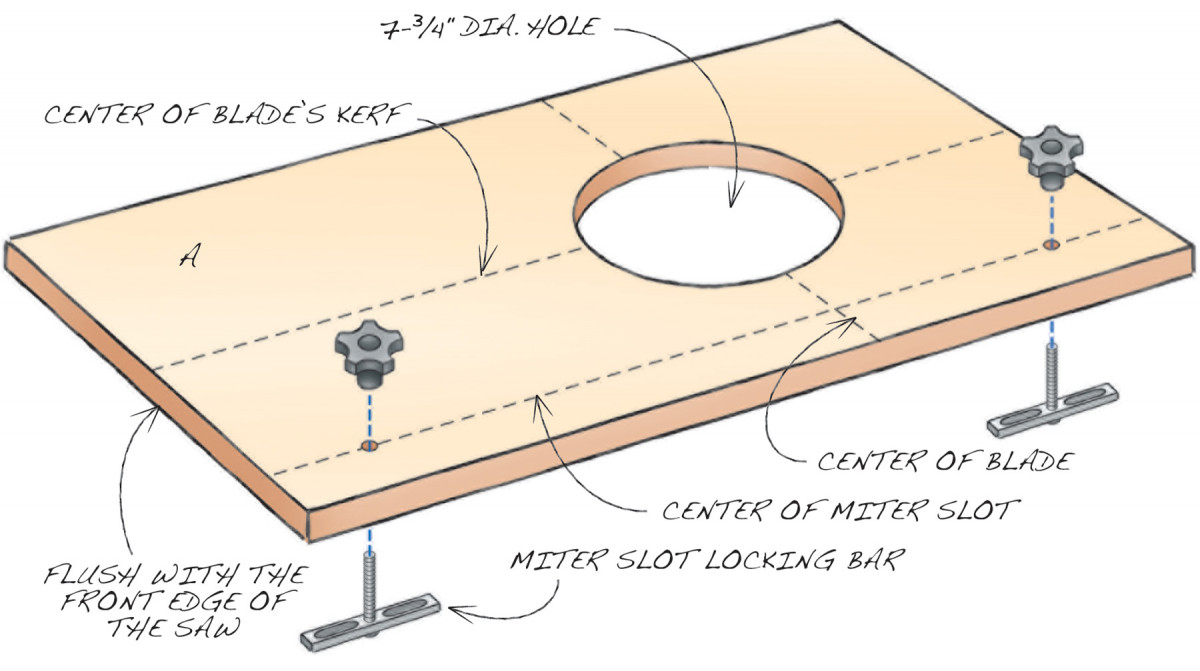
Fig. A) Hollowing Jig
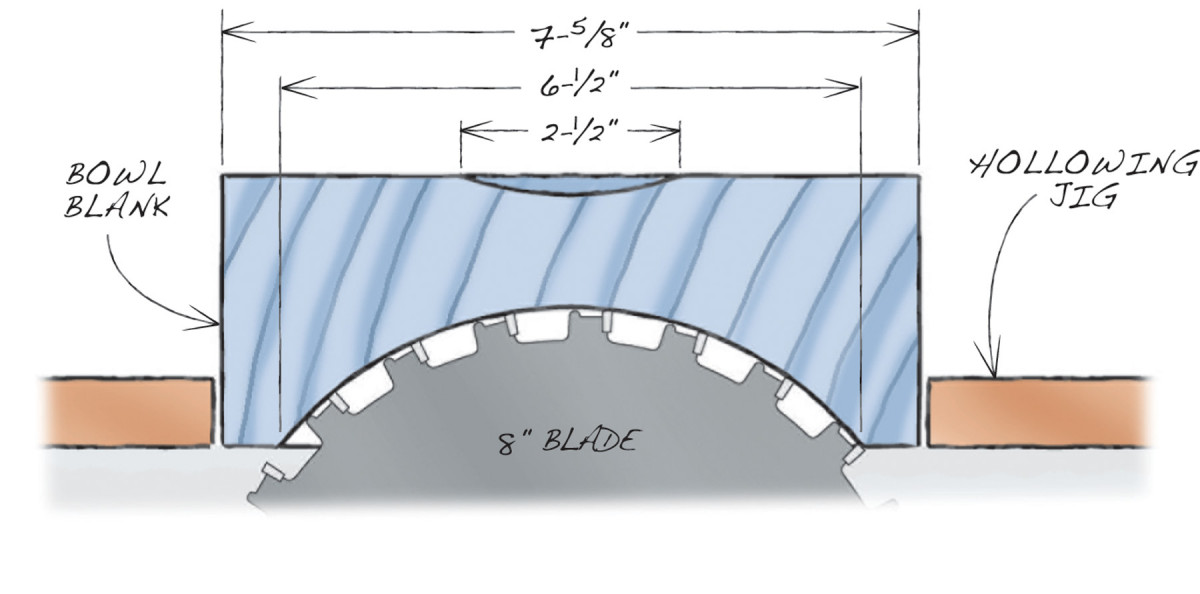
Fig. B) Cross Section of the Bowl in the Hollowing Jig
Making the Coping Jig
Start with the base (B). Draw the same three lines as you did for the coping jig. In addition, draw one line 5″ in front of the “center of saw blade” line (Fig. C).
To make the platform (C) and guide pieces (D), start by sawing six pieces 12″ wide by 11-1/2″ long. Saw a 45° bevel on one end of each piece (Fig. D). Set aside one of these pieces for the platform. Stack the rest, so the bevels line up, and crosscut each piece individually, so the square ends also line up. Glue the stack together. Mark the center of the hole that will hold the bowl blank. Saw the hole on the bandsaw, either freehand or using a circle-cutting jig. Saw off the sharp corners of the hole. Finally, cut out a 2″ wide by 3″ long slot in the end of the platform for dust extraction, then glue the stack to the platform. Glue and screw the platform and stack to the base.
Make the supports (E) and fasten them to the base. Make the dustport (F) and screw it to the supports.
Coping Jig Cut List
|
Part |
Name |
Qty. |
Th x W x L |
|
B |
Base 2 |
1 |
3/4″ x 18″ x 27″ |
|
C |
Platform |
1 |
3/4″ x 12″ x 11-1/2″ (a) |
|
D |
Guide |
5 |
3/4″ x 12″ x 11-1/2″ (b) |
|
E |
Support |
4 |
3/4″ x 6″ x 6″ |
|
F |
Dustport |
1 |
1/4″ x 4″ x 6″ |
Notes:
a) Miter one end.
b) Miter the ends of all pieces, then crosscut to length as shown in Fig. D.
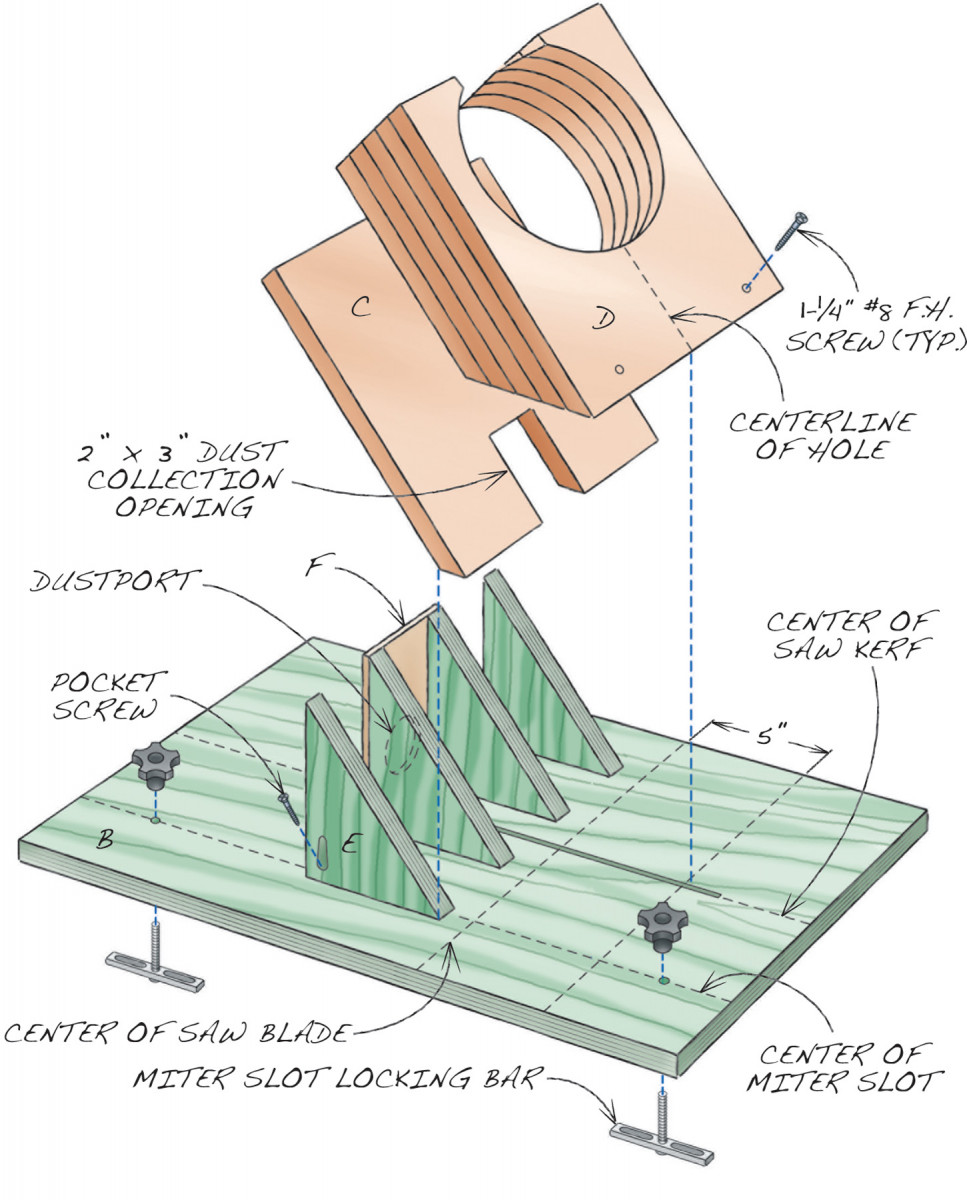
Fig. C) Coping Jig
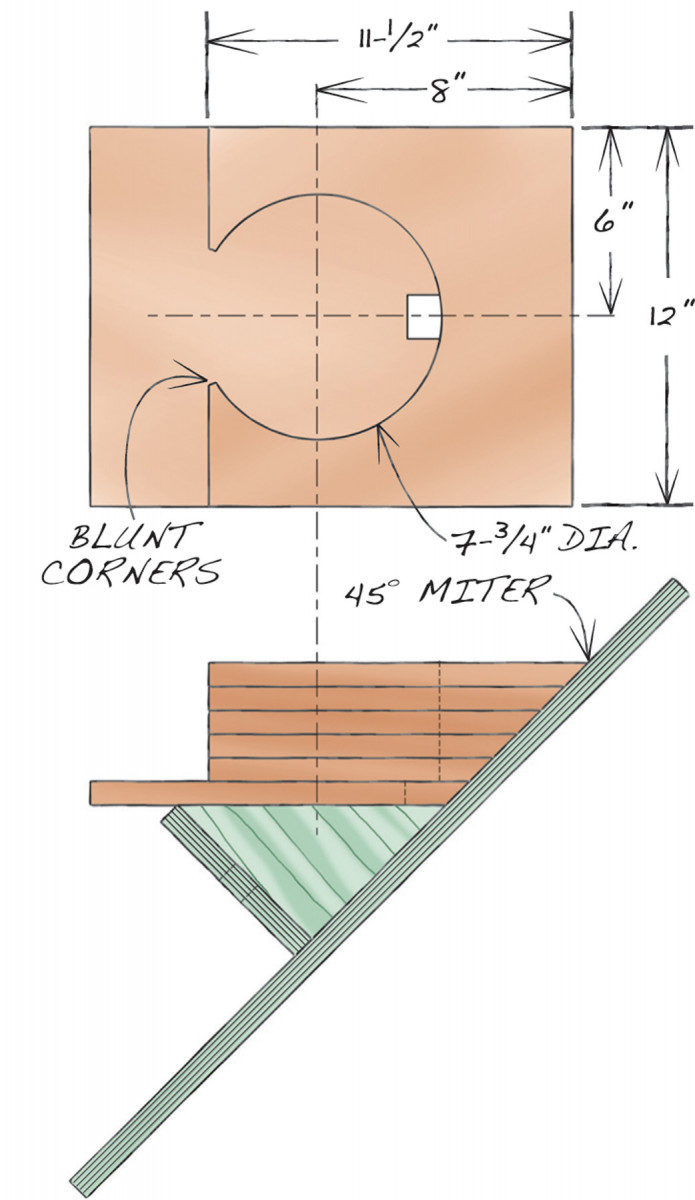
Fig. D) Top and Side Views of Coping Jig
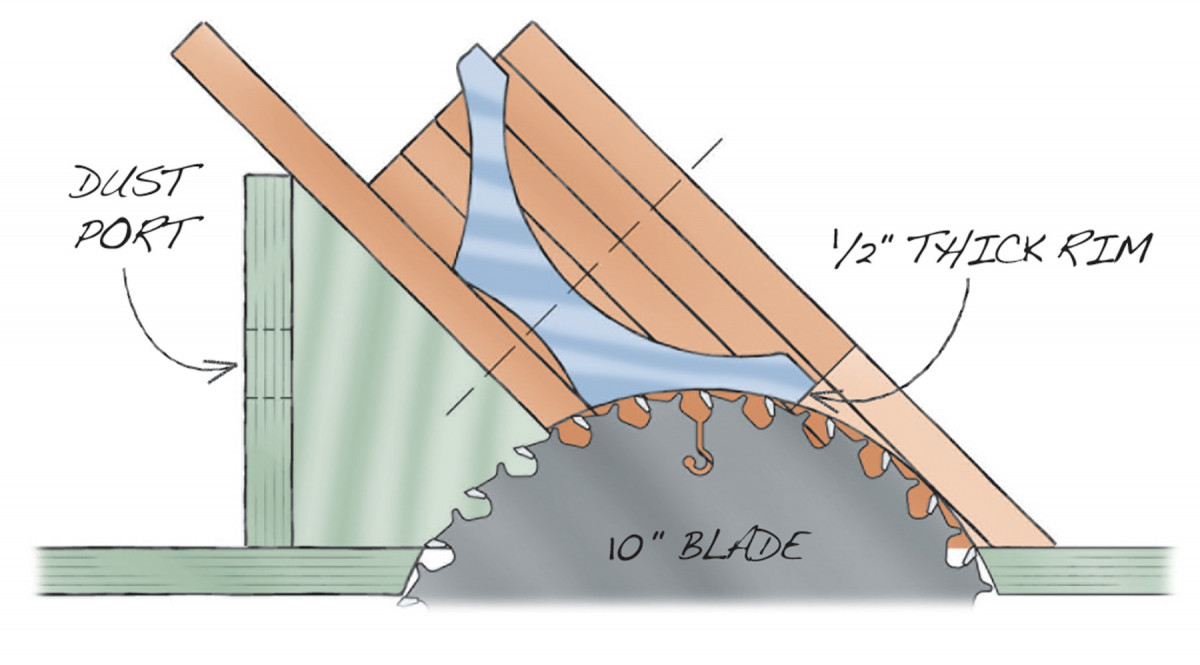
Fig. E) Cross Section of the Bowl in the Coping Jig
Here are some supplies and tools we find essential in our everyday work around the shop. We may receive a commission from sales referred by our links; however, we have carefully selected these products for their usefulness and quality.



